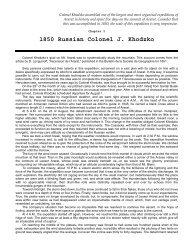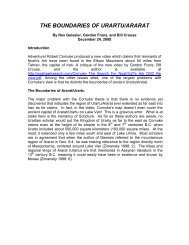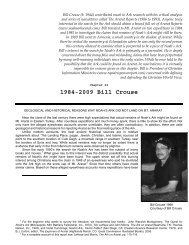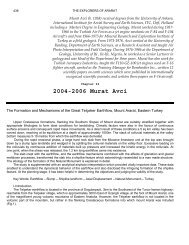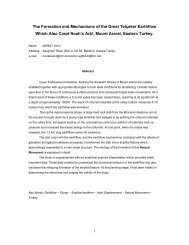1876 British Viscount & Ambassador James Bryce - Noah's Ark Search
1876 British Viscount & Ambassador James Bryce - Noah's Ark Search
1876 British Viscount & Ambassador James Bryce - Noah's Ark Search
You also want an ePaper? Increase the reach of your titles
YUMPU automatically turns print PDFs into web optimized ePapers that Google loves.
146 THE EXPLORERS OF ARARAT<br />
Still farther east, and occupying the center of Transcaucasia, are the Georgians, called by the Russians<br />
Grusinians or Grusians, who may be considered the principal and, till the arrival of the Muscovite, the dominant race of<br />
the country. They call themselves Karthli, deducing their origin from a patriarch Karthlos (who was brother of Haik, the<br />
patriarch of the Armenian nation, and of Legis, the ancestor of the Lesghians), a grandson, or, as others hold, greatgrandson<br />
of Gomer, son of Japheth. According to their own legends, they worshipped the sun and the moon and the<br />
five planets, and swore by the grave of Karthlos until converted to Christianity by St. Nina, in the fourth century of our<br />
era. For several centuries their kingdom extended almost to the Black Sea in one direction and the Caspian in another,<br />
and maintained itself with some credit against the hostility of Turks and Persians, though often wasted by Persian<br />
armies, and for long periods obliged to admit the suzerainty of the Shah. Its heroic age was the time of Queen Tamara,<br />
who flourished in the twelfth century, and is still honored by pictures all over the country, in which she appears as a<br />
beautiful Amazon, not unlike the fancy portraits of Joan of Arc. To her is ascribed the foundation of every ancient<br />
church or monastery, just as all the strongholds are said to have been built by the robber Kir Oghlu, and as in Scotland<br />
there is hardly an old mansion but shows Wallace’s sword and Queen Mary’s apartment. However, the coup de grâce<br />
was given by the invasion of the Persians, under Aga Mohammed Khan, in 1795, which reduced Georgia to such<br />
wretchedness that the reigning King George made over his dominions to Alexander I in 1799, and the country was<br />
finally occupied by Russian troops in 1802. One sees traces of a sort of feudal period in the numerous castles. The<br />
organization of society was feudal till quite lately, the peasantry serfs, the upper class landowning nobles and their<br />
dependants. It is a joke among the Russians that every Georgian is a noble; and as the only title of nobility is Prince,<br />
the effect to an English ear of hearing all sorts of obscure people, country postmasters, droshky drivers, sometimes<br />
even servants, described as being Prince So-and-so, is at first grotesque.<br />
Everyone has heard of the Georgian beauties, who in the estimation of Turkish importers rivaled or surpassed<br />
those of Circassia itself. Among them a great many handsome and even some beautiful faces may certainly be seen,<br />
regular and finely chiseled features, a clear complexion, large and liquid eyes, an erect carriage, in which there is a<br />
good deal of dignity as well as of voluptuousness. To a taste, however, formed upon Western models, mere beauty of<br />
features and figure, without expression, is not very interesting; and these faces have seldom any expression. It must<br />
be remembered, however, that this loveliness is rather fleeting. Towards middle life the complexion is apt to become<br />
sallow, and the nose and chin rather too prominent, while the vacuity of look remains.<br />
So early as the sixth century, Procopius compliments the Iberians (who are doubtless the ancestors of our<br />
Georgians) on their resolute adherence to Christian rites in spite of the attacks of the Persian fire-worshippers, who, it<br />
may be remarked in passing, seem to have been the first to set the example of religious persecution. The Muslims say<br />
that the Christianity of the Georgians is owing to their fondness for wine and for pork, both which good things, as<br />
everybody knows, the Prophet has forbidden to true believers. They belong, of course, to the Orthodox Eastern<br />
Church, and are now in full communion with the Church of Russia, of which indeed they may be said to have become<br />
a branch, though their liturgy differs a little in some points. During the earlier Middle Ages I suspect that they were<br />
more influenced by heterodox Armenia than by Constantinople, though they separated from the Armenian Church in<br />
the end of the sixth century, when the latter finally anathematized the Council of Chalcedon. Their ecclesiastical<br />
alphabet, for they have two, is taken from the Armenian. Of their number it is difficult to form an estimate; it can hardly<br />
exceed 500,000 souls, and may be considerably less.<br />
Scattered through Upper Georgia, and to be found among the peasantry as well as in the towns, there is a<br />
considerable Armenian population, who probably settled here when their national kingdom was destroyed by the<br />
Seljukian conquerors, Alp Arslan and Malek Shah, in the eleventh century. Farther south, in Armenia proper, they<br />
constitute the bulk of the population in the country districts, Kurds being mixed with them in the mountains, Tatars in<br />
the plains, and Persians in the towns. As I shall have something to say of them in a later chapter, it is unnecessary to<br />
describe them at present, further than to remark that they are the most vigorous and intelligent of the Transcaucasian<br />
races, with a gift for trade which has enabled them to get most of the large business of the country into their hands.<br />
Their total number in these countries is estimated at 550,000.<br />
Going down the Kur from Tiflis towards the Caspian, one finds the Georgians give place to a people whom the<br />
Russians call Tatars, and who are unquestionably a branch of the great Turkic family. When or how they settled here,<br />
no one can precisely tell, but it seems likely the earliest immigration was from the north, along the Caspian coast.<br />
There is no doubt that the Emperor Heraclius, in his long war with Persia in the middle of the seventh century, called in<br />
to his aid the Khazars, a Scythian tribe, from the Caspian steppe north of Derbend. Probably these Khazars were the<br />
first Turks who settled on this side of the mountains; but many others must have come in afterwards from the<br />
southeast at the time of the great Seljukian conquests in the eleventh century. Their villages, often mere burrows in the<br />
dry soil, are scattered all over the steppe eastward to the Caspian, and southward as far as the Persian frontier. Many<br />
are agricultural, many more live by their sheep and cattle, which in summer are driven up towards the Armenian<br />
mountains and in winter return to the steppe.<br />
The Tatars are also the general carriers of the country. On the few roads, or oftener upon the open steppe, one<br />
sees their endless trains of carts, and more rarely their strings of camels, fetching goods from Shemakha, or Baku, or<br />
Tavriz [Tabriz, Iran], to Tiflis, thence to be dispatched over the Dariel into Southern Russia, or by railway to Poti and<br />
Western Europe. The last of their occupations, the one in which they most excel, and which they have almost to<br />
themselves, is brigandage. If we had believed a quarter part of what the quidnuncs of Tiflis told us, we should have



